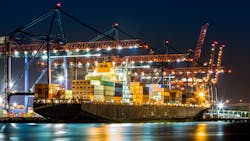Months into port labor talks, shippers fear more supply chain ramifications
As West Coast port labor negotiations drag on, the shipping industry is getting more concerned about supply chain and economic ramifications as the peak shipping season nears. Less than a year after a U.S. rail strike was narrowly avoided, a port strike would deal another blow to a U.S. freight industry that has been battling adversity since the decade began.
“The labor negotiations are nearing a pivotal point as fears of a strike increase,” Spencer Shute, principal consultant at Proxima, a global procurement and supply chain consultancy, told FleetOwner on Monday. “Recently, the unified front of press releases has started to wane and the labor groups have started to make adjustments to their work schedules. These adjustments have come with accusations of intentionally slowing the flow of cargo without going on strike. We’ve also seen many trade organizations, from trucking to agriculture, write letters urging the administration to step in.”
Some 238 national and local trade associations recently penned a letter to President Joe Biden, warning how the port uncertainty is already creating economic problems related to freight flow. This includes shippers diverting cargo from the West Coast, where import volumes recently sank to their lowest levels since the 1980s.
See also: EPA poised to grant California more rigid emissions rule than rest of nation
“Given the turmoil of the past several years, what our supply chain needs to see right now is continuity,” Chris Spear, American Trucking Associations’ (ATA) president and CEO, said on Friday. “Unfortunately, these ongoing negotiations—seemingly with no end in sight—are adding yet another stress factor that is complicating our industry’s ability to keep goods moving in a reliable and timely fashion. For the sake of our country, it’s time to bring these negotiations to a close."
Some 22,000 workers belong to the International Longshore and Warehouse Union, which has been in negotiations with the Pacific Maritime Association since May. The PMA represents management at 29 ports and distribution centers along the West Coast. The union has been working without a contract since July.
More than a month ago, the two sides issued a joint press release to announce they “continue to negotiate and remain hopeful of reaching a deal soon.” The parties said they would not discuss those negotiations in the media.
ATA and other local and state trucking organizations were among the trade groups that signed the letter to the White House, urging the administration to work with both sides of the contract negotiations to find a long-term agreement. The letter asks for Biden to appoint a new administration point person for the negotiations since former Labor Secretary Marty Walsh left the administration this winter.
Port activity shifts to East and Gulf coasts
“As we have witnessed, significant cargo flows have shifted away from the West Coast ports because of the uncertainty related to the labor negotiations,” the March 24 letter reads. “While there certainly are other issues impacting the West Coast ports, many cargo interests have expressly stated that they shifted cargo as a result of the negotiations. That cargo will not return to the West Coast until after a contract is final and approved by both parties. The longer there is no ratified contract only increases the probability that some portion of the freight will never return to the West Coast ports.”
After COVID-19 pandemic-related delays clogged the ports of Los Angeles and Long Beach for the past two years, the West Coast has lost market share to major East Coast ports. The Port Authority of New York and New Jersey supplanted Los Angeles as the busiest port in the U.S. this year. The Port of Savannah in Georgia has also seen its volume jump, according to a February report from Savallis.
As of February, East Coast and Gulf Coast ports now make up 52% of the market, Savallis reported. It was 44.5% in 2016.
'Supply chain stress' continues
“Even though cargo volumes have dropped, we continue to experience supply chain stress and challenges,” the letter to the White House notes. “While many continue to recover from the pandemic-related issues, the ongoing stress of inflation and economic uncertainty continues to impact supply chain stakeholders as well.”
The letter adds that while the trade groups appreciate that both sides agreed not to hold a strike or lockout, “we are aware of several instances that have impacted terminal operations. We need the administration to ensure these activities do not continue or escalate.”
See also: The detention time toll deserves a solution
The trade associations note that the only way to avoid a work stoppage is for both parties to remain at the bargaining table. They argue that the White House should help facilitate those negotiations, which have dragged on for 10 months.
“The increased tension is causing concern as shippers are starting to plan for peak season and will soon need to make decisions on when to ship and which ports to ship to in order to prevent excessive delays should a strike occur,” Proxima’s Shute said.
About the Author
Josh Fisher
Editor-in-Chief
Editor-in-Chief Josh Fisher has been with FleetOwner since 2017. He covers everything from modern fleet management to operational efficiency, artificial intelligence, autonomous trucking, alternative fuels and powertrains, regulations, and emerging transportation technology. Based in Maryland, he writes the Lane Shift Ahead column about the changing North American transportation landscape.


